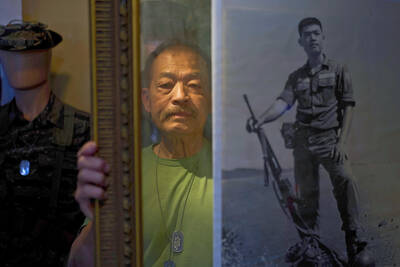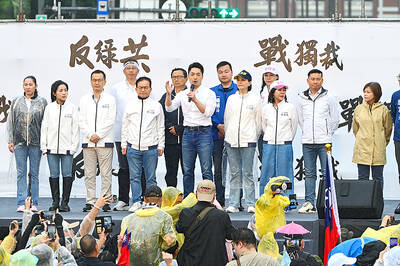Though the summer saw a slew of celebrity marriages, romance is cooling off in the autumn with several breakups. Receiving top billing, of course, is the hyper-public divorce of actress and singer Cecilia Cheung (張柏芝) and actor Nicholas Tse (謝霆鋒). After months of marital squabbles following the “airplane incident,” — the name given to an encounter in May between Cheung and Canto-pop star Edison Chen (陳冠希) — the couple confirmed that they were calling it quits at the end of last month.
And it would seem that the chance meet between the former lovers has also caused a permanent rift in Chen’s relationship with girlfriend Vincy Yeung (楊永晴), according to NOWnews and the China Times. Although Yeung stood by Chen following the 2008 photo scandal in which shots of him pictured in flagrante delicto were leaked to the public, she is alleged to have been furious about Chen and Cheung’s renewed friendship. Chen’s alleged booty call to lingerie model and ex-flame Gloria Wong (黃榕) in June probably didn’t help either.
Yeung has reportedly stopped following Chen’s microblog and refuses to take his calls.

Photo: Taipei Times
For his part, Chen, who is currently in New York, is trying to salvage the relationship by posting on his microblog cutesy images of himself alone with captions such as “Love” and “Where am I going now?”
Jolin Tsai (蔡依林), meanwhile, continues to fend off rumors that her boyfriend Vivian Dawson is a man about town. Yam News reported that Dawson spent a holiday in Thailand with Hong Kong model Hidy Yu (余曉彤) after pictures of the two frolicking were leaked on the Internet.
“Nothing has changed in our relationship,” Tsai told reporters when queried about the images. She added that she hopes to wed by age 40, according to the Apple Daily. Dawson, for his part, noted that he has been friends with Yu for years and that the photos were snapped years ago.
A storm in a teacup? Probably. Yu, who is also attached, admitted to touring Thailand with Dawson, but said the trip was too short to have sparked love.
In other celebrity squabbles, Hong Kong actress and UNICEF’s Ambassador to China Maggie Cheung (張曼玉) just can’t seem to hang on to her man. NOWnews reported that Cheung, 47, looked frail and drawn last week after rumors emerged that her 40-year-old squeeze of four years, architect Ole Scheeren, had taken an amorous interest in a 30-year-old fashion designer.
Hong Kong’s Oriental Sunday was more pointed. After spotting Cheung at a Hong Kong airport, the magazine reported that she had a “neck of tree roots, skeletal fingers and looked pitiful,” (樹根頸和白骨爪暴現, 實在是我見猶憐), which is a stark contrast to the almost celestial poise she usually displays.
Ole’s alleged indiscretions follow earlier rumors that he was two-timing Cheung with a 20-year-old colleague. The subtext to this news appears to be that Cheung should be dating someone her own age. As the Chinese media pointed out, she’s experienced “eight failed relationships and a broken marriage.”
But not everything is so gloomy on the romance front. At a press conference held last week to promote a jewelry exhibit, 18-year-old Hannah Quinlivan (昆凌) said she was ready for marriage, reported the Liberty Times (the Taipei Times’ sister paper). This follows on the heels of a trip to France last month with alleged beau Jay Chou (周杰倫). But Quinlivan was quick to quash rumors they are a couple, stating that they slept in separate beds. She added that it wasn’t fair to assume they were a couple if they weren’t photographed holding hands.
In other wedding news, Selina Jen (任家萱) and fiance Richard Chang (張承中) aren’t sleeping together, sina.com reported. Chang said at a charity auction last week that he’s been sleeping on the couch since the couple moved into new digs. But fans of the couple needn’t be concerned their relationship and betrothal are on the rocks. The gallant Chang has been keeping out of the bedroom because “Selina’s skin is still very fragile,” he said, adding that Jen has to wear a suit that covers her body to help her recover from burns received in an accident last year.
“Her hands are wrapped up like Doraemon,” Chang said, referring to the Japanese manga character that has balloon-like hands. Jen will wear a specially designed bandage at their wedding, scheduled for Oct. 31, so Chang can fit the ring on her finger.

When the South Vietnamese capital of Saigon fell to the North Vietnamese forces 50 years ago this week, it prompted a mass exodus of some 2 million people — hundreds of thousands fleeing perilously on small boats across open water to escape the communist regime. Many ultimately settled in Southern California’s Orange County in an area now known as “Little Saigon,” not far from Marine Corps Base Camp Pendleton, where the first refugees were airlifted upon reaching the US. The diaspora now also has significant populations in Virginia, Texas and Washington state, as well as in countries including France and Australia.

On April 17, Chinese Nationalist Party (KMT) Chairman Eric Chu (朱立倫) launched a bold campaign to revive and revitalize the KMT base by calling for an impromptu rally at the Taipei prosecutor’s offices to protest recent arrests of KMT recall campaigners over allegations of forgery and fraud involving signatures of dead voters. The protest had no time to apply for permits and was illegal, but that played into the sense of opposition grievance at alleged weaponization of the judiciary by the Democratic Progressive Party (DPP) to “annihilate” the opposition parties. Blamed for faltering recall campaigns and faced with a KMT chair

As we live longer, our risk of cognitive impairment is increasing. How can we delay the onset of symptoms? Do we have to give up every indulgence or can small changes make a difference? We asked neurologists for tips on how to keep our brains healthy for life. TAKE CARE OF YOUR HEALTH “All of the sensible things that apply to bodily health apply to brain health,” says Suzanne O’Sullivan, a consultant in neurology at the National Hospital for Neurology and Neurosurgery in London, and the author of The Age of Diagnosis. “When you’re 20, you can get away with absolute

A police station in the historic sailors’ quarter of the Belgian port of Antwerp is surrounded by sex workers’ neon-lit red-light windows. The station in the Villa Tinto complex is a symbol of the push to make sex work safer in Belgium, which boasts some of Europe’s most liberal laws — although there are still widespread abuses and exploitation. Since December, Belgium’s sex workers can access legal protections and labor rights, such as paid leave, like any other profession. They welcome the changes. “I’m not a victim, I chose to work here and I like what I’m doing,” said Kiana, 32, as she